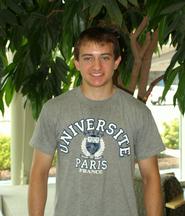
National studies have revealed that women who have had multiple pregnancies before the age of 30 are at a significantly decreased risk for breast cancer, and scientists believe that a certain protein produced by the fetus, called alpha-fetoprotein, may hold the key to this reduction.
A small, four amino acid peptide derived from this protein is essential to alpha-fetoprotein’s activity, and a previous study by former Winslow Professor of Chemistry George Shields demonstrated a common shape for this peptide and several synthetic relatives.
The research of Shields, who is now the Dean of Arts and Science at Bucknell University, is being continued by Daniel Mermelstein ’14 under the direction of Silas D. Childs Professor of Chemistry Emeritus Robin Kinnel.
Mermelstein, a chemistry major, is conducting research that includes synthesizing compounds that adopt the shape described by Professor Shields and that hold promise for having therapeutic use.
One of Mermelstein’s primary tasks is to synthesize lead compounds that include the four amino acid sequence found to have anti-cancerous properties. Small peptides are extremely reactive in the hostile environment of the human stomach or bloodstream. Mermelstein’s task is to create a more resistant depsipeptides compound that can withstand the body’s protective mechanisms while still retaining its anti-cancer properties. To do this, he plans to make a ring out of the straight peptide sequence that includes an ester, which should give the compound a greater resistance to degradation and make it more likely to get to target cancer cells.
Because these peptides have shapes, or conformations, that have been described only computationally, how they might behave within the aqueous environment of human body is not clear. In order to better understand their conformation, Mermelstein is observing the peptide sequence in water with a device known as the nuclear magnetic resonance spectrometer (NMR), which uses magnetic analysis of proton environments to paint a picture of the peptide’s structure and conformation.
Since the only data in existence on these peptides comes from Professor Shield’s computations, Mermelstein’s NMR analysis is on the forefront of research regarding these sequences. Research has shown that these peptides are highly subject thermal motion, which makes NMR analysis difficult. Mermelstein, however, has shown that adding zinc to the peptides slows down their random motion by forming a complex, which appears to have generated promising data.
So far, many of the reactions attempted by Mermelstein to form the depsipeptides have failed to function as expected. “Peptides can be very finicky,” he said, “and this is my first time running some of the tests on the NMR, so it makes for a bit of a learning curve.” These challenges make his work even more exciting when things go right. “When something looks like it may have worked, it’s hard not to get excited, but the reality of our work means that we need to keep a calm and level head,” he remarked.
Mermelstein finds his work studying possible cancer-fighting drugs to be both challenging and rewarding. He says that he loves the idea that his work “could be doing something to help people … and to change the world, even if only a little bit.” Mermelstein has planned to go to graduate school since he entered Hamilton, but after this summer’s research, he is even more resolved to study postgraduate biochemistry in the hope of continuing disease and pharmaceutical research.
Mermelstein is a graduate of Vestal High School (N.Y.)
